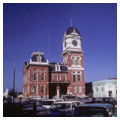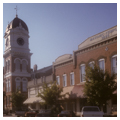One of several county courthouses in Georgia designed by architects Bruce and Morgan, this architectural mix of Italian Villa and French Second Empire styles presents a striking image of the dominant form of local government in nineteenth- and early-twentieth-century Georgia. There are 159 counties in the state, more than any state with the exception of Texas, and across Georgia courthouses typically surpass city halls in architectural stature. They are generally the principal public building in town, usually dominating the town’s centrally located courthouse square.
The Newton County Courthouse is the work of one of Atlanta’s most prominent early firms, a partnership formed barely a year prior to this project when a well-established Tennessee architect, Alexander C. Bruce, joined the younger Thomas H. Morgan in architectural practice. Bruce and Morgan became the region’s preeminent specialists in courthouse design, rivaled only by J. W. Golucke. In the 1870s, before he came to Atlanta, Bruce had designed no fewer than five courthouses in Tennessee. With his first Georgia partner, William C. Parkins, Bruce designed courthouses in Hancock (1882) and Fulton (1883) counties. Even after Bruce’s departure for partnership with Morgan, Parkins remained active in courthouse design.
Bruce and Morgan designed some of Georgia’s most memorable courthouses, demonstrating an eclectic creativity in the handling of Romanesque Revival forms, rich ornament, and picturesque compositions that often featured towers. Their courthouses have a character-defining stability and architectural weight that reminds us that H. H. Richardson was at his peak during Bruce and Morgan’s formative years, and that Richardson’s Romanesque forms were a model for public and institutional architecture throughout the nation during the 1880s and 1890s. Thus, Bruce and Morgan’s many courthouses were conceived mostly as variations on Romanesque themes, producing the towered masonry piles that dominated their rural Georgia towns. The courthouses were almost always sited on a courthouse square, either in the center of the square or on a side, with the surrounding buildings facing the square that served mainly commercial purposes.
The 1884 courthouse for Newton County caps its tower with a mansard roof and displays other Second Empire features. Bruce and Morgan’s Walton County courthouse of the previous year, as well as their now lost Hall County Courthouse in Gainesville (destroyed by a tornado in 1936) were also styled in the French Second Empire fashion. But by 1887, the firm preferred Romanesque Revival as evidenced in their public works over the next eleven years, including county courthouses still extant for Paulding (1892), Haralson (1892), Talbot (1892), Floyd (1893), Bullock (1894), Monroe (1896), and Butts (1898).
Around 1904, Bruce left the partnership and practiced for a year under his own name, and then with A. F. N. Everett as Bruce and Everett. John Robert Dillon joined the Morgan practice, which continued after 1904 as Morgan and Dillon, designing the Early County Courthouse the following year. In 1911, with A. Ten Eyck Brown, Morgan and Dillon erected the still extant and monumental Fulton County Courthouse in Atlanta, a great palazzo for justice that replaced Parkins and Bruce’s picturesque 1883 Fulton County courthouse.
The Newton County Courthouse underwent a major restoration in 2004, spearheaded by Jack Pyburn, now of Lord Aeck Sargent. It remains today one of Georgia’s memorable late Victorian buildings, located in a town nicknamed the “Hollywood of the South.” So iconic is the Newton County Courthouse that it was used in the opening credits of the television show In the Heat of the Night (1988–1994). It has turned up repeatedly as a backdrop television shows and movies ranging from the Dukes of Hazzard and The Cannonball Run in the 1970s to the Vampire Diaries in 2009 and after.










